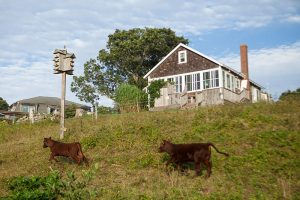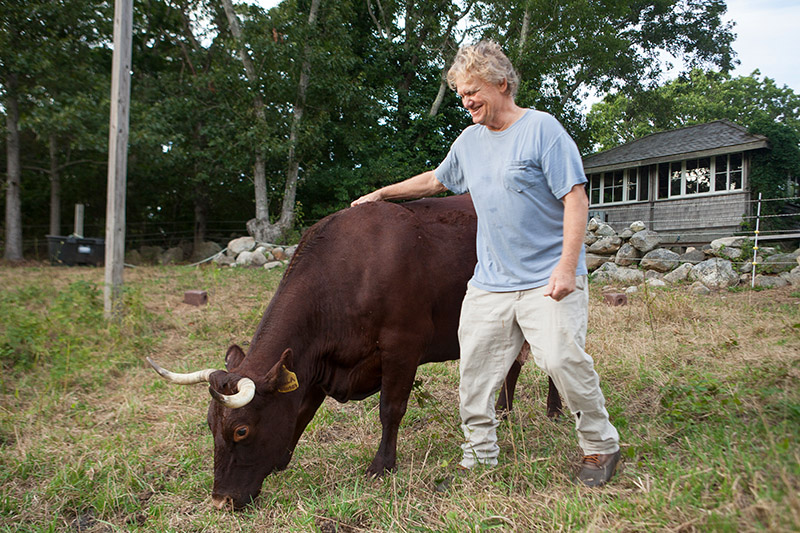I’m not a big cow person. They’re sort of like rural wallpaper, nothing to get overly excited about. And then I saw my first North Devon or Ruby Red cow out at the Beach Plum Inn in Menemsha. What a magnificent beast. The horns were long, creamy white and tipped with brown; the coat was like velvet, a deep, almost burgundy shade.
Standing next to her in the pasture, my first instinct was to give her a big hug; however, Bob Nixon, owner of the Beach Plum, advised me to be careful. The Devons have a wonderful disposition, he said, but if you happen to get too close, and one inadvertently swings its great horned head back to shoo a fly, you could be shish kebab.
So how does the owner of a bucolic country inn (who’s also a documentary filmmaker) end up with a herd of cattle? Mr. Nixon took delivery on six of these gorgeous creatures on August 3, and prior to that time he spent nearly 10 years researching various breeds.
The Beach Plum Inn is surrounded by six pastures, which over the years have been home to flocks of sheep and at one time even a small herd of cattle. Plus, Mr. Nixon comes from a wildlife background. As a young man he started out to be a marine biologist — but flunked biology.
He then decided to become a photographer and document endangered species. He worked as an apprentice to master falconer Phillip Glasier in England, and then established a raptor education program at the Wildlife Preserve in Maryland under the guidance of master falconer Jim Fowler, the co-host of “Mutual of Omaha’s Wild Kingdom.” It was here that he had his first encounter with cattle. He was allowed to live in a shack on a farm rent-free if he agreed to feed the cows.
Many years later, Mr. Nixon would look around the Beach Plum Inn and decide that the many pastures surrounding the property needed restoring. Cows did a better job of converting plants to fertilizer than sheep, and his research on cows led him to North Devons.
For one thing, Devons are super-friendly and docile, which is good if you’re operating an inn that’s open to the public. Also, Devons are not known to be jumpers. Mr. Nixon once had several Herefords on the property, but they had a way of jumping over fences. He got tired of the chief of police calling from the Menemsha docks, saying, “Bob, you’ve got some cattle down here by the Texaco station.”
There were other practical considerations, as well. Devons can fend for themselves, and require very little maintenance. They eat around 40 pounds of foliage a day, which would help to clear pastures — as Mr. Nixon said, “They love their salad bar.”
And they don’t require much shelter in the winter. Mr. Nixon just has a little lean-to where the cattle can get out of the weather. So from a practical standpoint, he was sold. But he also liked the tradition behind the North Devons.
North Devon cattle are from Devonshire, a district in England, and were the first cows brought to America; if you look at old paintings of Devon in the 17th century, the cows depicted were Devons. They were brought here in 1623 by the Pilgrims on the ship Charity. The reason the Pilgrims chose Devons was because of the hardiness and practicality of the breed. They were great milking cows, excellent for beef, and made hard-working oxen.
Erick Taylor, owner of Devon Point Farm in Woodstock, Conn., is one of the larger breeders of North Devons in the country, and he claims that Devons are what made America America. They cleared the way for farms, moved boulders, pulled plows, built roads, hauled wagons, and provided food and dairy for the settlers.
By the 1700s they had spread down the coast as far as Florida, and in the 1800s became the draft animal of choice on the Oregon Trail. During the Revolutionary War, when Colonel Henry Knox went to Fort Ticonderoga in New York to steal heavy weapons for the Continental Army, Devons dragged them back to Boston.
So from both a practical standpoint and from a traditional standpoint, Mr. Nixon was sold on North Devons. But there’s a bit of a wrinkle here.
By the 1950s, the market for multipurpose cattle like the traditional North Devons had diminished, and as a result, the breeder community split.
The majority of breeders began to breed for beef production in order to compete with other beef breeds. This population was called the Devon or the Beef Devon. A few breeders still preferred multipurpose cattle and continued to select their animals for meat, milk, and draft; this population was called the American Milking Devon, North Devons, or Ruby Reds. There is a simple way to tell the two breeds apart.

Because of crossbreeding, most Beef Devons are born poled (without horns), It makes them easier to transport in enclosed areas. So if you’re looking for the original line of Devons that came from England, it’s the North Devons, the ones with the magnificent horns. However, they’re on an endangered species list; there are only about 1,200 North Devons alive today.
It was those great horns that originally drew Mr. Nixon to the Devon breed. Years ago, the house next to the Beach Plum Inn was owned by Evelyn Flanders. Mr. Nixon saw a painting over the mantle which showed a cow with a huge set of horns. Mr. Nixon mistook it for a Texas Longhorn. He learned that it was, in fact, a Devon cow, and that may have been where his fascination with this breed began, a fascination that culminated with him acquiring six North Devons from Mr. Taylor of Devon Point Farm: three cows and three calves (two female calves and one little bull).
As a sidebar, the cows have an interesting naming convention. The mothers and the calves have the same first letter in their names in order to keep them straight, i.e. Violet and Vegan, Pippa and Peaches, etc.
Nixon has modest ambitions for his North Devons: He foresees bringing in a bull to stud in the spring; he might eventually like to have around 10 cattle in all. The chef at the Beach Plum can make cheese from their milk, and eventually there will be beef, but as much as anything, Mr. Nixon just enjoys watching these amazing animals; he finds them totally mesmerizing. “I have an office down by the pasture,” he said, “and I can’t get any work done; I just sit and watch the cows all day.”
And he’s not alone. People at the inn go down to the pasture after breakfast and sit on benches, gazing out at the cows. “I heard someone say the other day,” said Mr. Nixon, “‘Tom, this is the most relaxed I’ve ever been.’”




